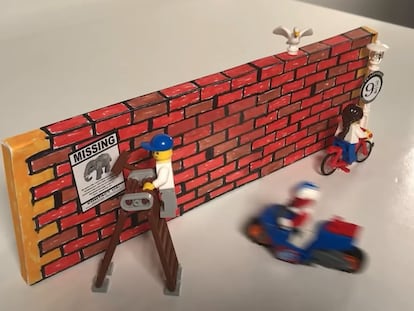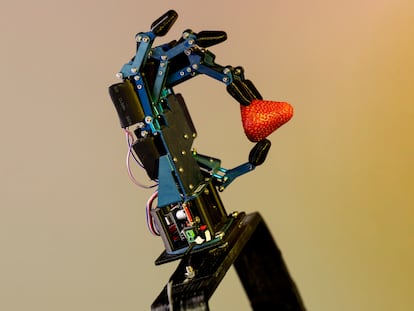LEGO recreation of magic ‘Harry Potter’ railway platform wins Best Illusion of the Year
An intriguing construction recreates the famous Platform 9 3/4 at King’s Cross, through which the young wizard and his peers disappeared on their way to Hogwarts

How did the characters from the Harry Potter saga manage to get through the wall on platform 9 3/4 at London King’s Cross? It could be magic, but it could also be an optical illusion, as the winner of the 18th edition of the Best Illusion of the Year competition demonstrates.
Organized by neuroscientists from the Neural Correlation Society with the support of the Museum of Illusions to “foster public awareness of perceptual and cognitive research,” the competition is ultimately decided by fans with the three best entries voted on from “a select group of 10 finalists, previously selected by an international committee of impartial experts in illusions.”
The three most-voted illusions were the recreation of the famous Harry Potter platform with Tower of Cubes? and Cornelia, an arresting portrait of a woman with a face that emerges and appears to come to life, completing the podium. Besides the satisfaction of leaving viewers mouths agape, the three winners also took home checks for $3,000, $2,000 and $1,000, respectively.
In this link are the entries presented by the 10 finalists and below are the videos showing the three winners, together with the jury’s description of the illusions and the creators’ own comments on their work.
First prize. Platform 9 3/4 was created by Matt Pritchard, an illusionist from the UK. Inspired by the Harry Potter universe, this anamorphic illusion shows a toy car and LEGO figures apparently slipping through a solid brick wall.
Creator’s description. According to Pritchard, there is, in reality, a hole the size of the car in the middle of the wall for the toy to drive through. The empty space is replaced by an anamorphic illusion on the floor behind the wall. When viewed from a specific angle, the vertical and horizontal bricks line up and appear to form a single solid wall. The pattern camouflages the edges and makes it extremely difficult to distinguish between the two.
Second prize. John Salmon, from Brigham Young University in the United States, impressed the judges with his Tower of Cubes? illusion.
Creator’s description. In this illusion, two perfectly identical 3D-printed towers of cubes were revealed to be quite different than they appeared at first glance. According to Salmon, the viewer is shown a tower created with three perfect 3D printed cubes on the left, next to a tower on the right. Once assembled, a straight wooden rod is inserted through the tower on the left, from top to bottom. The rod is also inserted through the tower of cubes on the right, but now it appears to bend around the structure in a surprising and impossible manner. The illusion is resolved by disassembling the tower on the right, revealing distorted 3D printed cubes.
Third prize. Dutch artist Wendy van Boxtel, who lives in Virginia in the U.S., submitted Cornelia, a sculpture that plays with the illusion of the hollow mask, where a woman’s face and hair gradually emerge from a painting.
Creator’s description. “After discovering hollow mask illusions, I became obsessed with creating an inside-out sculpture where the face and hair would gradually emerge from the painting, in order to create a custom illusion that would capture people’s attention,” says the artist. “I experimented with many materials, colors, and depth, and after several attempts, I found a method that worked. You might think it would fool everyone’s eye, but not exactly. People who have schizophrenia have a disconnect between what the eye sees and what the brain processes, and are unable to see the illusion.”
Sign up for our weekly newsletter to get more English-language news coverage from EL PAÍS USA Edition
Tu suscripción se está usando en otro dispositivo
¿Quieres añadir otro usuario a tu suscripción?
Si continúas leyendo en este dispositivo, no se podrá leer en el otro.
FlechaTu suscripción se está usando en otro dispositivo y solo puedes acceder a EL PAÍS desde un dispositivo a la vez.
Si quieres compartir tu cuenta, cambia tu suscripción a la modalidad Premium, así podrás añadir otro usuario. Cada uno accederá con su propia cuenta de email, lo que os permitirá personalizar vuestra experiencia en EL PAÍS.
¿Tienes una suscripción de empresa? Accede aquí para contratar más cuentas.
En el caso de no saber quién está usando tu cuenta, te recomendamos cambiar tu contraseña aquí.
Si decides continuar compartiendo tu cuenta, este mensaje se mostrará en tu dispositivo y en el de la otra persona que está usando tu cuenta de forma indefinida, afectando a tu experiencia de lectura. Puedes consultar aquí los términos y condiciones de la suscripción digital.
More information
Archived In
Últimas noticias
NASA discovers Titan doesn’t have an ocean, but a ‘slushy ice layer’ that increases possibility of life
Innocence lost in the forest of the child soldiers: ‘Each leader of the armed group had his girls’
‘Fallout’ or how the world’s largest company turned an anti-capitalist apocalyptic Western into a phenomenon
From inflation to defending migrants: Eileen Higgins and Zohran Mamdani inaugurate the new Democratic resistance against Trump
Most viewed
- Christian Louboutin: ‘Young people don’t want to be like their parents. And if their parents wear sneakers, they’re going to look for something else’
- ‘El Limones’ and the growing union disguise of Mexican organized crime
- The low-cost creative revolution: How technology is making art accessible to everyone
- ‘We are dying’: Cuba sinks into a health crisis amid medicine shortages and misdiagnosis
- Liset Menéndez de la Prida, neuroscientist: ‘It’s not normal to constantly seek pleasure; it’s important to be bored, to be calm’











































